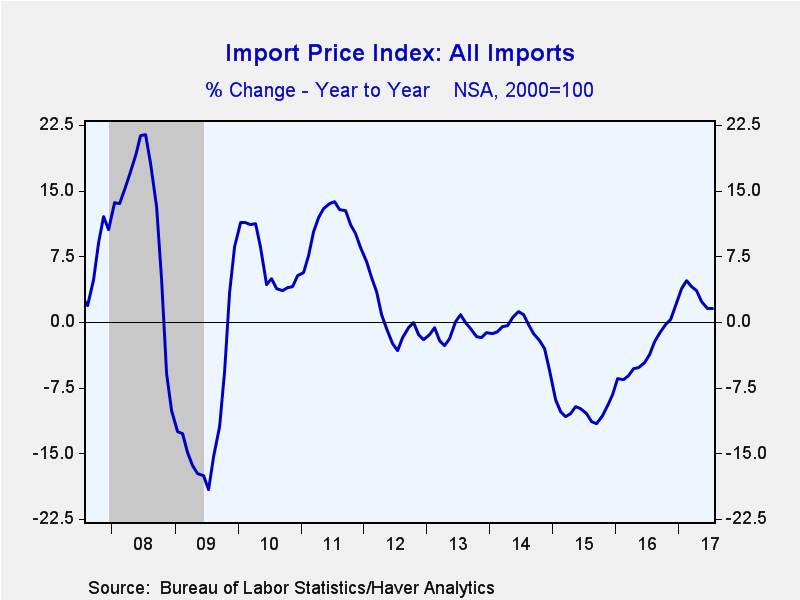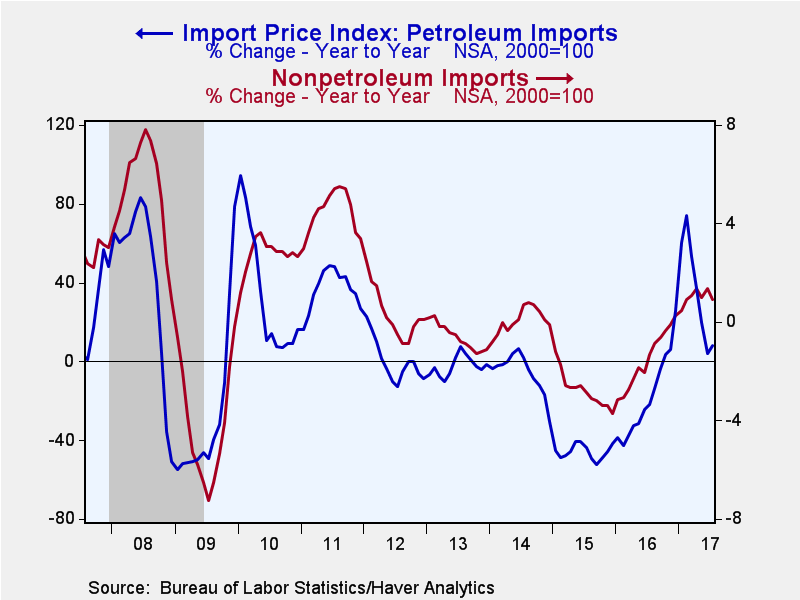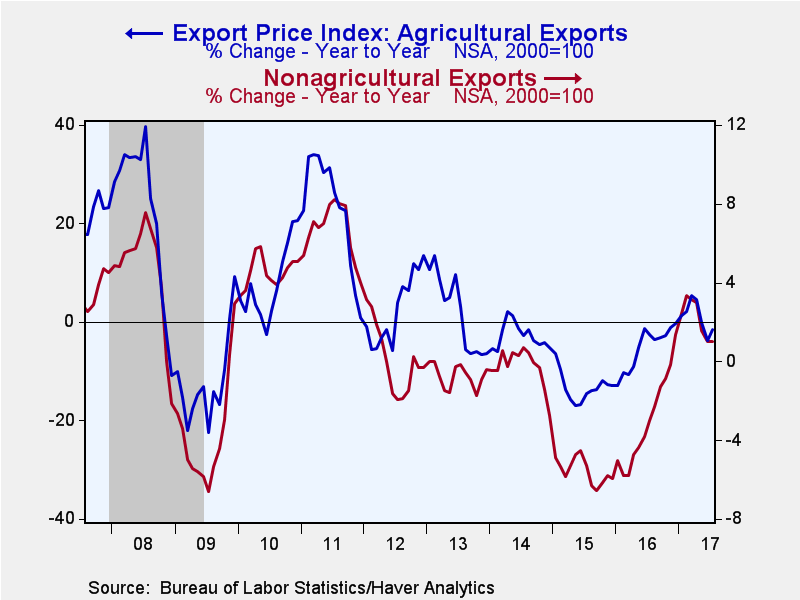 Global| Aug 15 2017
Global| Aug 15 2017Petroleum Prices Push Up U.S. Import Prices in July; Export Prices Propelled by Ag Prices
by:Sandy Batten
|in:Economy in Brief
Summary
After two consecutive monthly declines, import prices edged up 0.1% m/m (1.5% y/y) in July. They had fallen 0.2% m/m in June and 0.1% m/m in May. The July increase was exactly in line with the Action Economics Forecast Survey, which [...]
After two consecutive monthly declines, import prices edged up 0.1% m/m (1.5% y/y) in July. They had fallen 0.2% m/m in June and 0.1% m/m in May. The July increase was exactly in line with the Action Economics Forecast Survey, which had looked for a 0.1% m/m rise. These figures are not seasonally adjusted.
Petroleum import prices rose 0.7% m/m (8.3% y/y), their first monthly increase in five months. Nonpetroleum import prices were unchanged in July from June (+0.9% y/y). Among end-use categories, industrial supplies and materials prices excluding petroleum eased -0.5% (+3.9% y/y) after a 0.1% m/m increase. Among other detail categories, prices of foods, feeds and beverages rose 0.6% m/m (+3.2% y/y) after a 1.1% m/m jump in June. Capital goods prices edged up 0.1% m/m (0.2% y/y) following a 0.2% m/m gain in June. Prices of motor vehicles and parts eased 0.2% (-0.2% y/y), the same decline as in June. The prices of consumer goods excluding automobiles were unchanged in July as they had been in June.
Export prices increased 0.4% m/m (0.8% y/y) in July, after having declined in each of the preceding two months. The Action Economics Survey expected a more modest 0.2% rise. The July increase was propelled mostly by a 2.1% m/m (-1.4% y/y) jump in agricultural commodity prices after two months of meaningful declines. Nonagricultural export prices were up a more modest 0.3% m/m (1.0% y/y) after having been unchanged in June.
Among the end-use categories for exports, overall foods, feeds and beverage prices jumped 2.4% m/m (-1.3% y/y) following a 1.5% m/m decline in June. Prices of industrial supplies and materials were up 0.4% m/m (3.0% y/y) after having declined in each of the two previous months. Nonagricultural supplies and materials prices excluding fuels and building materials increased 0.3% m/m (0.5% y/y) after having fallen 1.6% over the preceding three months. Prices of motor vehicles and parts slipped 0.1% (-0.1% y/y), the same decline as in June. Capital goods prices edged up 0.1% m/m (0.8% y/y) and non-auto consumer goods prices rose 0.2% (-1.7% y/y) on top of a 0.2% m/m increase in June.
The import and export price series can be found in Haver's USECON database. Detailed figures are available in the USINT database. The expectations figure from the Action Economics Forecast Survey is in the AS1REPNA database.
| Import/Export Prices (NSA, %) | Jul | Jun | May | Jul Y/Y | 2016 | 2015 | 2014 |
|---|---|---|---|---|---|---|---|
| Imports - All Commodities | 0.1 | -0.2 | -0.1 | 1.5 | -3.3 | -10.2 | -1.1 |
| Petroleum | 0.7 | -2.9 | -0.8 | 8.3 | -19.7 | -46.0 | -5.6 |
| Nonpetroleum | 0.0 | 0.1 | 0.0 | 0.9 | -1.5 | -2.8 | 0.1 |
| Exports - All Commodities | 0.4 | -0.2 | -0.5 | 0.8 | -3.2 | -6.3 | -0.5 |
| Agricultural | 2.1 | -1.4 | -1.6 | -1.4 | -5.4 | -13.3 | -2.7 |
| Nonagricultural | 0.3 | 0.0 | -0.4 | 1.0 | -3.0 | -5.5 | -0.3 |
Sandy Batten
AuthorMore in Author Profile »Sandy Batten has more than 30 years of experience analyzing industrial economies and financial markets and a wide range of experience across the financial services sector, government, and academia. Before joining Haver Analytics, Sandy was a Vice President and Senior Economist at Citibank; Senior Credit Market Analyst at CDC Investment Management, Managing Director at Bear Stearns, and Executive Director at JPMorgan. In 2008, Sandy was named the most accurate US forecaster by the National Association for Business Economics. He is a member of the New York Forecasters Club, NABE, and the American Economic Association. Prior to his time in the financial services sector, Sandy was a Research Officer at the Federal Reserve Bank of St. Louis, Senior Staff Economist on the President’s Council of Economic Advisors, Deputy Assistant Secretary for Economic Policy at the US Treasury, and Economist at the International Monetary Fund. Sandy has taught economics at St. Louis University, Denison University, and Muskingun College. He has published numerous peer-reviewed articles in a wide range of academic publications. He has a B.A. in economics from the University of Richmond and a M.A. and Ph.D. in economics from The Ohio State University.










